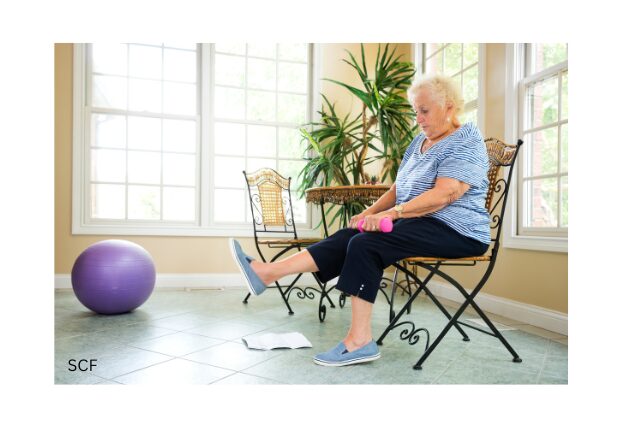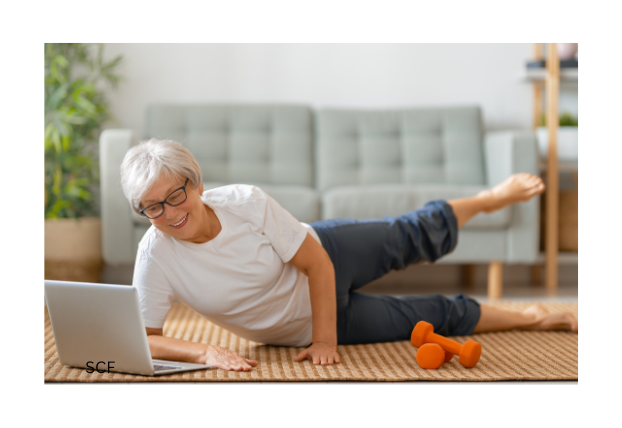Exercise isn’t just about staying fit—it’s a gateway to improved mental health, independence, and a higher quality of life, especially for seniors. Designing a home workout routine tailored to your needs ensures safety, effectiveness, and enjoyment. Whether you’re new to fitness or looking to refresh your routine, this guide will help you create a senior-friendly workout plan that supports both body and mind.
1. Why Home Workouts Are Ideal for Seniors
Home workouts are a game-changer for seniors. They eliminate the need for gym visits, allowing you to stay active in a comfortable and familiar environment. Plus, they’re adaptable, so you can exercise at your own pace and customize your routine to match your fitness level.
Benefits of Home Workouts:
- Convenience: No commute or gym memberships needed—just a bit of space and some simple equipment.
- Safety: Exercising at home means fewer distractions and hazards, reducing the risk of injury.
- Flexibility: Work out on your own schedule and tailor routines to your specific needs.
- Cost-Effective: Many exercises require little to no equipment, making them accessible for everyone.
Example:
Mary, a 68-year-old retiree, started a home workout routine using only a sturdy chair and light resistance bands. Over time, she noticed increased strength, better balance, and improved mobility—all from the comfort of her living room.
Home workouts are an excellent way for seniors to stay active while maintaining control over their environment and pace.
2. Designing a Senior-Friendly Workout Plan
Creating a workout plan tailored to seniors involves a mix of strength, balance, flexibility, and cardiovascular exercises. The key is to focus on low-impact activities that are safe and easy to perform.
Key Elements of a Routine:
- Warm-Up:
-
- Activities like walking in place, gentle arm circles, or slow leg swings prepare your muscles and joints for exercise. Spend 5–10 minutes warming up to prevent injuries.
- Example: March in place for 2 minutes while gently swinging your arms.
- Strength Training:
-
- Build muscle and bone strength with exercises like chair squats, wall push-ups, and seated bicep curls using light weights or resistance bands.
- Example: Perform 10 chair squats by standing up from a chair and sitting back down slowly, keeping control of the movement.
- Balance Exercises:
-
- Simple moves like standing on one leg or heel-to-toe walking help improve coordination and prevent falls.
- Example: Practice standing on one leg for 10 seconds at a time, holding onto a wall or chair for support if needed.
- Flexibility and Core Work:
-
- Stretching and core exercises, like planks or seated twists, enhance mobility and stability.
- Example: Try the bird dog exercise by getting on hands and knees, extending one arm and the opposite leg, and holding for a few seconds.
- Cool Down:
-
- Gentle stretching helps relax your muscles and prevent stiffness.
- Example: Perform a seated forward bend by sitting on a chair, extending your legs, and reaching toward your toes.
Bonus Tip:
Incorporate tools like resistance bands, stability balls, or light dumbbells to add variety and challenge. These tools are inexpensive and can enhance your workout.
3. Adapting Workouts to Your Needs
Not all exercises are a one-size-fits-all solution. Seniors should adapt their routines based on their fitness levels, health conditions, and personal preferences.
Steps to Personalize Your Routine:
- Assess Your Abilities: Identify what feels comfortable and where you may need modifications.
-
- Example: If full push-ups are too challenging, start with wall push-ups for a gentler alternative.
- Consult Your Doctor: Before starting any exercise program, check with your healthcare provider to ensure the activities are safe for you.
- Set Realistic Goals: Focus on achievable milestones, such as walking for 10 minutes a day or completing 15 squats.
- Listen to Your Body: Pay attention to signs of fatigue or discomfort and adjust your exercises as needed.

4. Practical Tips and Resources
Sticking to a workout routine can feel daunting at first, but with the right tools and mindset, it becomes a rewarding habit.
Tips for Success:
- Create a Schedule:
-
- Dedicate specific days and times for your workouts to build consistency.
- Example: Aim for 30 minutes of exercise, 3–5 times a week.
- Use Free Resources:
-
- Explore free apps and YouTube channels designed for senior fitness. These platforms offer guided routines and motivation.
- Example: Apps like SilverSneakers GO provide low-impact workout plans tailored for seniors.
- Keep It Fun:
-
- Mix up your routine with different activities to prevent boredom.
- Example: Alternate between yoga, walking, and light resistance training.
- Stay Safe:
-
- Ensure your workout space is clutter-free and well-lit to avoid accidents.
- Example: Use a non-slip yoga mat for exercises that require standing or stretching.
- Find a Partner:
-
- Exercising with a friend or family member adds accountability and makes workouts more enjoyable.
- Example: Join a virtual fitness group to connect with others while staying active.
Consistency is key. The more you stick to your routine, the more benefits you’ll see over time.
5. The Benefits of Home Workouts for Seniors
Regular exercise offers a wealth of benefits, especially for seniors. Beyond physical health, it also boosts mental well-being and enhances daily life.
Physical Benefits:
- Improved Strength: Builds muscle mass and supports joint health.
- Better Balance: Reduces the risk of falls and enhances coordination.
- Increased Flexibility: Improves mobility and makes everyday tasks easier.
Mental Benefits:
- Reduced Stress: Exercise releases endorphins, helping to alleviate anxiety and improve mood.
- Sharper Mind: Physical activity boosts brain function and memory.
Example:
Jane, an 80-year-old who started a simple workout routine, found that daily stretching and balance exercises not only eased her back pain but also gave her more confidence to move around her home independently.
By embracing regular workouts, seniors can enjoy a healthier, happier, and more active lifestyle.

Conclusion: Take Charge of Your Fitness Journey
Creating a home workout routine is one of the most empowering steps seniors can take to maintain their health and independence. With exercises tailored to your abilities, the right resources, and a consistent schedule, staying active becomes both achievable and enjoyable.
Start small, listen to your body, and celebrate every milestone along the way. Remember, the goal isn’t perfection—it’s progress. By dedicating just a little time each week to movement, you’re investing in your overall well-being and quality of life.
So clear a space, grab a sturdy chair or resistance band, and get moving. Your future self will thank you!


